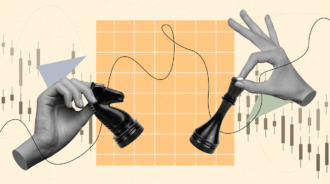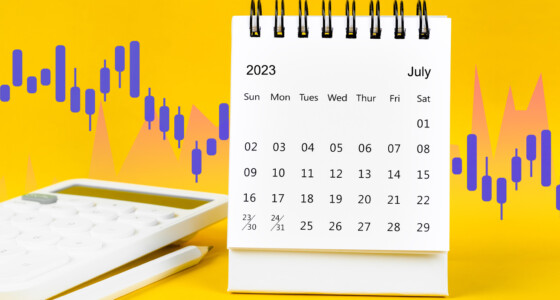

As an investor, you always seek new ways to maximize returns and diversify your portfolio. One tactic that can help accomplish both goals is cross trade. It involves simultaneously buying and selling related stocks, indexes, or other securities to capitalize on temporary price discrepancies and inefficiencies in the market. By executing these trades quickly, you can generate profits from the difference between the buy and sell prices. However, cross trade also comes with risks like increased volatility and transaction costs. To determine if cross trade is right for your investment strategy, you need to understand exactly what it is and how it works and see some examples of how to execute these trades.
What Is Cross in Trading? Definition and Overview
Cross trade refers to the practice of trading security between two or more accounts to benefit one party, often at the expense of another. It involves buying and selling the same security almost simultaneously between related accounts to manipulate the price.
The steps of basic cross trade are as follows:
- Buying a security in one account to drive the price up.
- Selling the same security from another related account at an inflated price to generate a profit.
This unethical practice is illegal according to securities law because it can be used to inflate the value of security artificially. Regulators closely monitor for signs of cross trade.
Some examples of cross trade include:
- A fund manager buys shares of a security in one fund they manage and sells shares of the same security from another fund they manage at a higher price. This benefits one fund at the cost of the other.
- A broker buys shares of a thinly traded microcap stock in a customer account to push the price up. The broker then sells the shares at a higher price from their own account to profit, disadvantaging the customer.
In summary, cross trade should be avoided as it violates laws against market manipulation. It harms innocent investors and undermines the integrity of financial markets. Legitimate trading should always aim for transparency and fair valuation of securities.
How Cross Trade Works: The Mechanics Explained
To understand how cross trade works, let’s start with an example. Trader A wants to buy 100 shares of Company X, and Trader B wants to sell 100 shares of Company X. Normally, these trades would be matched on an exchange with an anonymous counterparty.
With cross trading, however, Trader A’s and Trader B’s brokers, who know about both parties’ interests, will match the traders’ orders directly. This benefits both traders by avoiding exchange fees and ensuring a speedy transaction at a mutually agreed-upon price.
The Steps Involved
- Trader A instructs their broker to purchase 100 shares of Company X. Trader B tells their broker to sell 100 shares of Company X.
- The brokers, aware of both clients’ orders, match Trader A’s bid with Trader B’s ask. They negotiate the price and terms that satisfy both traders.
- Once Trader A and Trader B confirm, the brokers facilitate the exchange of shares for payment between the two accounts.
- The brokers collect a fee for facilitating the transaction. While lower than exchange fees, cross trade still provides brokers revenue.
- Traders A and B get their orders filled at an acceptable price without having to go through an exchange.
Why Pursue Cross Trade?
Cross trade benefits both traders and brokers. Traders get lower fees and faster, more tailored transactions. Brokers generate revenue through facilitating private trades. Cross trade also provides more anonymity and control over pricing for traders.
Of course, there are risks like lack of transparency that traders should consider. But when executed properly, cross trading offers an efficient alternative to public exchanges.
Why Do Traders Use Cross Trading Strategies?
Cross trading allows traders to maximize profits by taking advantage of price differences in related financial instruments. There are a few key reasons why traders employ cross trading strategies:
Arbitrage Opportunities
Cross trade is often used to capitalize on arbitrage opportunities in the market. Arbitrage refers to profiting from price differences in related assets. Traders can buy an undervalued asset and sell an overvalued one to lock in risk-free profits. For example, a trader may buy gold futures and sell gold ETF shares if there is a price discrepancy between the two instruments.
Hedging Risk
Cross trade can also be an effective hedging tool for traders to reduce risk. By taking offsetting positions in related markets, traders can hedge their exposure. For instance, a trader with long equities may short stock index futures to hedge against potential losses in the stock market. The gains in one position can offset the losses in another.
Speculation
Some cross trading strategies are also speculative in nature. Traders count on the relative performance or spread between two related instruments in the hopes of generating profits. For example, a trader may buy technology stocks and short the broader market if they believe the tech sector will outperform. The trader is speculating on the spread between the two markets.
Leverage
Cross trade often allows traders to gain exposure to markets with more leverage than by trading the underlying assets alone. The use of derivatives like futures and options can magnify both gains and losses. Traders need to manage their risk exposure carefully.
In summary, cross trade is a useful trading technique that can provide opportunities for arbitrage, hedging, speculation, and leverage. However, the increased complexity also brings higher risks that traders must understand and manage properly. With the right strategy and risk management, cross trade can lead to substantial profits for traders.

Examples of Common Cross Trading Setups
Cross trade is a trading strategy used by institutions and professional traders to exploit temporary price differences between correlated financial instruments or markets. There are several common types of cross trading setups:
Currency crosses are among the most popular cross trades. They involve buying and selling correlated currencies, such as EUR/USD and GBP/USD. Traders analyze the relative value between the pairs and buy the relatively undervalued currency while shorting the overvalued one. The goal is for the spread between the pairs to converge, at which point the trade is exited.
Intermarket spreads involve trading instruments from different markets that are historically correlated, such as bonds and stocks. For example, a trader may buy Treasury bonds while shorting the S&P 500 stock index, betting the spread between the yields will narrow. These trades are often placed around events like Federal Reserve announcements that can impact both markets.
Relative value trades look for price differences between related instruments like a stock and its options or convertible bonds. Traders buy the undervalued security and short the overvalued one. For example, a trader may buy a stock and sell call options on that stock, betting the options are overvalued relative to the stock price.
Merger arbitrage, also known as “risk arbitrage”, involves buying and shorting the stocks of companies involved in a merger or acquisition. Traders bet that the spread between the stock prices will narrow as the deal approaches completion. The most common setup is to buy the target company’s stock and short the acquiring company’s stock. The trade is exited once the deal is finalized and the spread between the stocks converges.
Cross trade requires extensive knowledge of the securities involved as well as a methodical approach. But when implemented successfully by skilled traders, cross trade can be a profitable strategy for exploiting market inefficiencies and temporary price dislocations between correlated instruments.
The Golden Cross: A Popular Trading Indicator
What is the golden cross in trading? It is a popular technical indicator used in trading. It occurs when a short-term moving average crosses above a long-term moving average. Typically, the 50-day and 200-day moving averages are used to identify a golden cross. When the 50-day moving average crosses above the 200-day moving average, it signals a breakout and the potential for a long-term rally.
How the Golden Cross Works
The golden cross is a bullish signal that the trend in a stock or index has turned positive. It indicates the shorter-term moving average has crossed above the longer-term moving average, confirming an uptrend may be starting. Traders will often look for a golden cross to trigger new long positions in a stock, believing it signifies the momentum has shifted to the upside.
The opposite of a golden cross is a “death cross”, when a short-term moving average crosses below a long-term moving average. This is seen as a bearish signal, indicating a potential for lower prices.
For the golden cross to be a valid signal, it’s best when both moving averages are trending higher at the time of the cross. The steeper the moving averages, the more bullish the signal. Also, look for high trading volume to confirm the breakout. A golden cross accompanied by heavy volume points to greater conviction behind the move.
Examples
The golden cross is often used by technical analysts and cross traders to determine entry or exit points in the stock market, commodities, bonds, and indices. For example, when the 50-day S&P 500 moving average crosses above the 200-day moving average, it signals the potential for a major new up leg in the overall stock market. Similarly, a golden cross in Apple stock may prompt a trader to buy the shares in anticipation of a sizable rally.
The golden cross can be an effective tool for cross trade when used in conjunction with other technical indicators like trendlines, support levels, and trading volume. But as with any indicator, it should not be used in isolation. A golden cross is best used to confirm an already established uptrend with the potential for further gains.
Conclusion
As you have learned, cross trade is a complex trading strategy that can be risky but also potentially rewarding. By executing buy and sell orders for different clients on opposite sides of the same trade, brokers can match buyers and sellers efficiently while also generating commissions on both sides of the transaction. While critics argue this can create conflicts of interest, proponents counter that cross trade provides liquidity and price improvement. If considering cross trade for your portfolio, do thorough due diligence on the brokerage and understand all fees involved. With the right broker and strategy, cross trade may be a useful tool for achieving your trading goals. The key is going in with a full understanding of how it works and the motivations of all parties involved.











